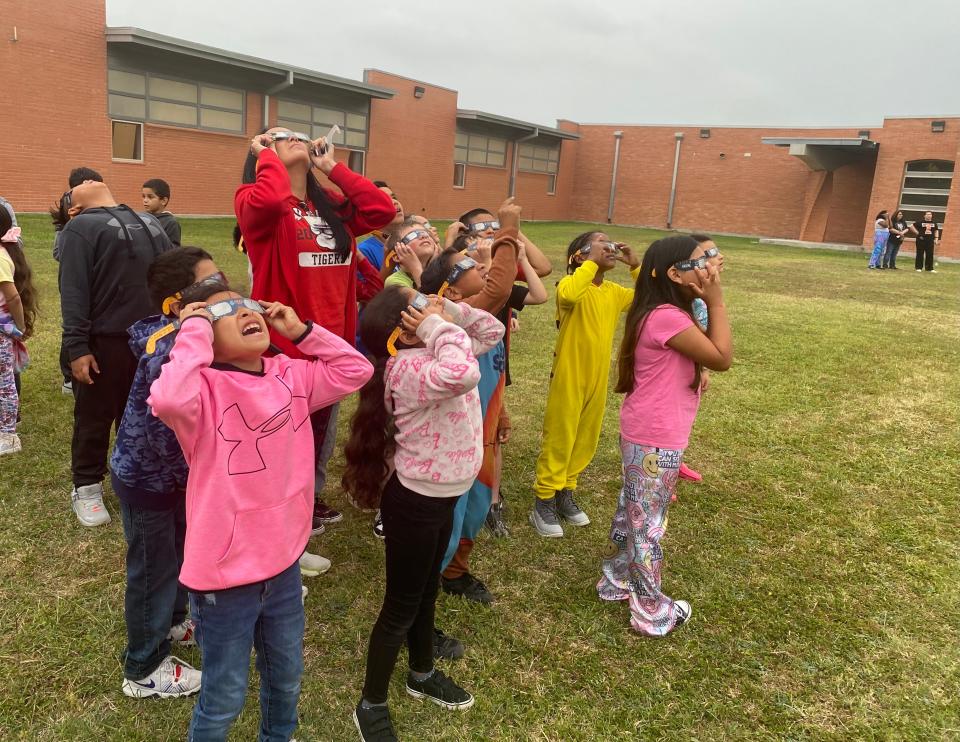Despite clouds, Oak Park Elementary School teaches all about the eclipse
As the moon crossed in front of the sun Monday afternoon over Oak Park Elementary School, the clouds were thick in the sky.
Students dutifully kept their eclipse glasses over their eyes, though there wasn’t much to see. Then, for a few seconds, a sliver of sun shone through the clouds.
“I see it!”
“I can’t see anything.”
“Oh, I see it!”

Results were mixed as second grade teachers Amber Martinez and Stacy Flores’s students tried to catch a glimpse of the celestial event.
The light might have dimmed a little, principal Federico Saqui observed, as though it was 6 p.m. instead of 1:30 p.m.
But regardless of whether they saw the eclipse with their own eyes, students did learn all about the phenomenon that day in the classroom.
“They were completely excited,” Flores said. “I know I had perfect attendance.”
Inside the school before the eclipse, Flores and second grade teacher Jared Ulch told students about different types of eclipses, including total solar eclipses, when the moon blocks out all of the sun’s light; partial solar eclipses, when the moon covers just part of the sun; and annular eclipses, when a ring of sun is visible behind the dark circle of the moon.
Solar eclipses are visible somewhere on Earth every few years, but often over the ocean. For individuals, experiencing a solar eclipse without having to travel is a rare experience.
“What happened when there was a total eclipse 600 years ago?” Flores said. “Birds fell from the sky. They thought it was night-time.”
Corpus Christi was not on the pathway for a 100% total eclipse, Flores told the students, but most of the sun was set to be covered Monday.
Eclipses aren’t part of a typical school year, but related topics like phases of the moon are a part of the normal curriculum and tied in with Monday's lesson, Flores said.
Though it ended up being too cloudy for students to see much, the teachers were careful to stress eye-safety. Eclipse glasses are much darker than sunglasses, blocking out everything but the sun, Ulch said.
“Does that mean they’re broken? No,” Ulch said. “No — the sun is so bright it’s the only thing you can see. They are not broken, they work perfectly. Keep them on outside.”
Corpus Christi ISD provided eclipse glasses or viewers for all students in first grade through fifth grade at Oak Park Elementary School.
In addition to attempting to see the eclipse outside, students were also shown livestreamed video footage from NASA.
The second graders also colored and put together pictures of the earth, moon and sun to learn about how eclipses are possible.
“The teacher taught us the solar eclipse happens, the moon comes in front of the sun,” second grader Amethyst Mahan said as she colored in Martinez’s classroom.
The last time a total solar eclipse crossed the U.S. was 2017 when the path crossed from Oregon to South Carolina. Martinez told the class about this eclipse as well.
“I was still a baby then,” second grader Jalice Flores said.
It will be decades before another total solar eclipse crosses the U.S.
Before the eclipse, the students asked a lot of good questions, Martinez said. They wanted to know what would happen if they looked at the eclipse without glasses and if it was safe to look at the eclipse through a phone.
“They’re so prone with technology, they were asking those questions,” Martinez said.
Flour Bluff ISD wetlands ambassadors to share research with community
FAFSA submissions down so far, but still time to submit
What to know about "beachcombing" — Jace Tunnell highlights strange beach finds
This article originally appeared on Corpus Christi Caller Times: Despite clouds, Oak Park Elementary School teaches eclipse

